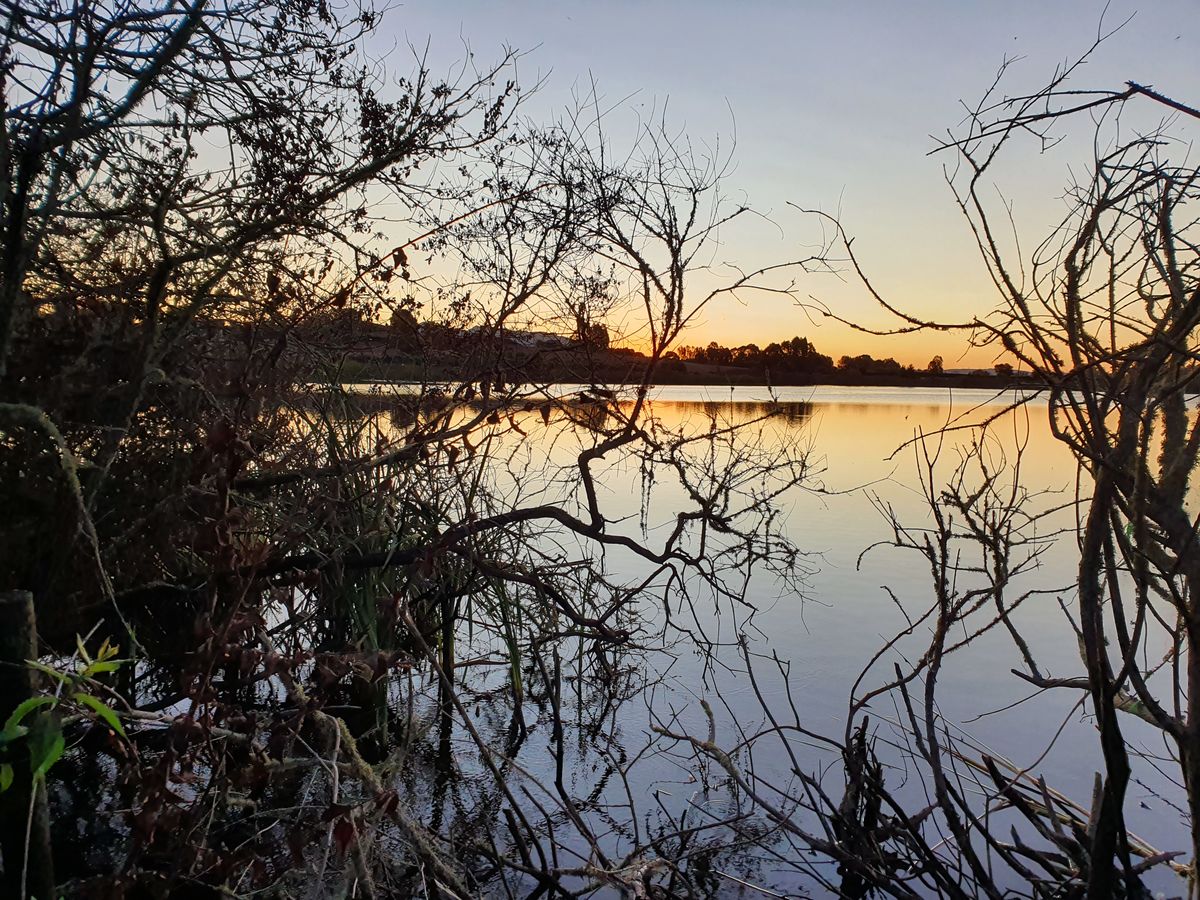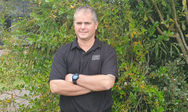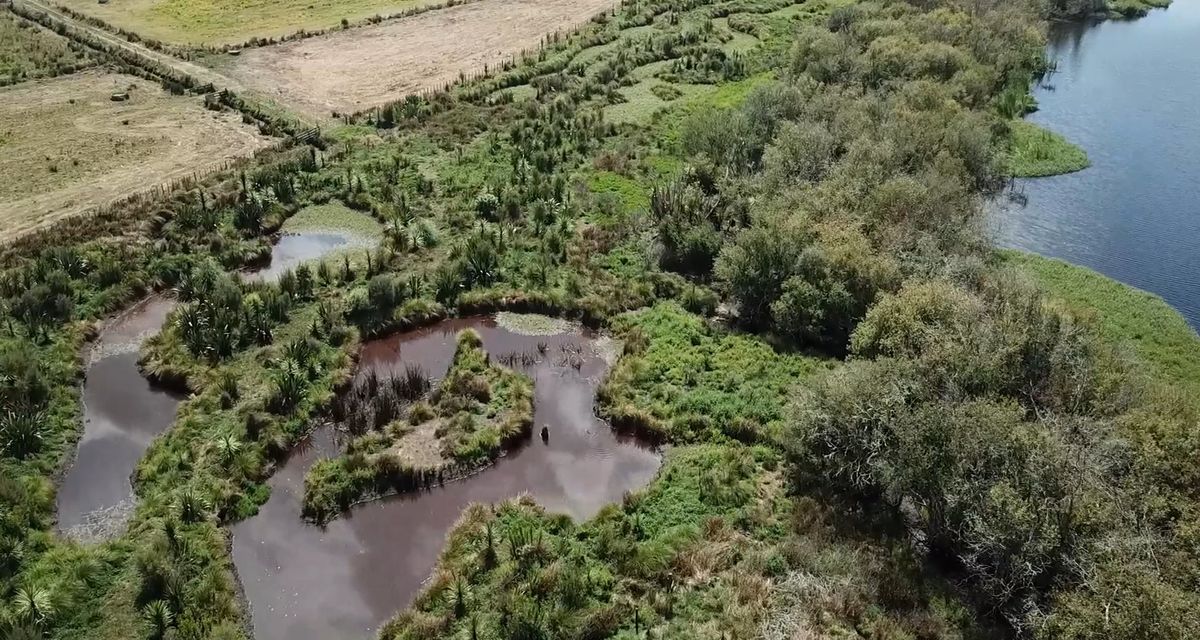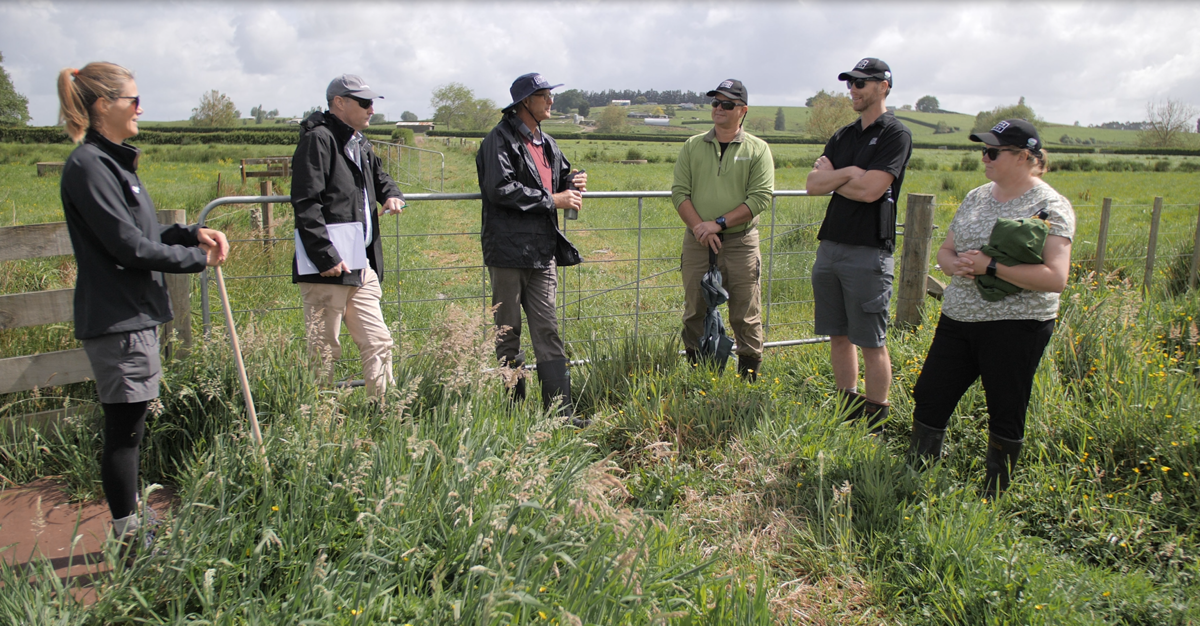
Lake Ruatuna: A demonstration site
What is this problem?
The Waikato peat lakes, classified as ‘acutely threatened’, are one of the world’s rarest ecosystems of importance historically, culturally and environmentally.
Lake Ruatuna is one of the peat lakes, owned by the government and surrounded by farmland, 19 kilometres south of Hamilton. It’s just under two metres deep and 13 hectares in size. The area has long been special to Māori. In the 1800s, iwi including Ngāti Apakura had productive gardens throughout the current Waipā District.
A report commissioned in 2015 by Living Water identified at least 29 indigenous plant species at Lake Ruatuna. There were seventeen native bird species observed in the catchment, including six threatened or at-risk species such as the Spotless Crake / pūweto, Australasian bittern / matuku, and dabchick / weweia. Sediment and nutrient run-off from surrounding farms and land uses were damaging the lake ecosystem, and enabling pest species to proliferate. Urgent action was required to prevent the lake and the indigenous species it supports from perishing.
What is this project?
In 2018 Living Water decided to focus most of its remaining efforts on Lake Ruatuna to achieve the greatest impact. The aim is to transform Lake Ruatuna into a demonstration site with tangible restoration outcomes, working with the community groups and engaged stakeholders.
Living Water decided to tap into local knowledge and experience by partnering with iwi Ngāti Apakura (mana whenua), farmers, the Lake Ruatuna users group, the regional and district councils and schools to work on the lake and its surrounds, creating a community movement that could accelerate the restoration of Lake Ruatuna.

Dion Patterson

Rose Graham

What has been done?
Ngāti Apakura have collaborated with Living Water to ensure the direction of work aligns with Mātauranga Māori. The partnership began with planning sessions between Ngāti Apakura and Living Water to support iwi to manage and monitor their environmental taonga. One project with Ngāti Apakura is the planting of a Pā harakeke / rongoā garden and Nature Education Trail. In November 2020 35 flax plants from 11 different species were planted with a focus on varieties used for weaving. In September 2021 approximately 900 more rongoā plants were planted.
Partnerships with local authorities are delivering excellent outcomes for restoring the lake. The Waipa District Council (WDC) administers some of the reserve land around the lake, including the amenity block and its surrounds (DOC administers the rest). The WDC negotiated and acquired a 30-metre esplanade reserve strip beyond the pre-existing margin, for ongoing restoration. Planting with native vegetation is providing valuable habitat for rare wetland birds such as the Pūweto / Spotless Crake, while helping filter nutrients out of the water.
The restoration work has benefited from an innovative partnership between DOC and the Department of Corrections called ‘Good to Grow’. Teams of community service workers are facilitated by ‘Good to Grow’ at certain times of the year to work up to three days a week at the lake (or work offsite, for example making picnic tables or traps).
Living Water has worked with the surrounding landowners (three lifestyle properties and four farms) to reduce sediment entering the waterways and lake. Only two farms share significant boundaries with drains entering the lake. One is primarily dry stock (dairy support), while the other is a Fonterra dairy farm.
In 2016 Living Water installed sediment traps at Lakes Ruatuna to reduce the amount of sediment entering the lakes from the neighbouring properties to improve water quality and habitat for aquatic life. More traps were installed at Lake Ruatuna in 2018. Analysis of monitoring data from the sediment traps showed that their performance was highly variable.
In 2019 a water quality survey report recommended planting in and around the sediment traps. It advised planting some of the tree-lined inlets with groundcover to filter surface runoff and overland flows, and planting tall sedges and grasses along unplanted drains to improve stability and to shade/cool the water. Native aquatic plants have been planted inside the traps to slow water flow, reduce water temperature, collect sediment around their roots and oxygenate the water, preventing algae blooms and stagnation.
Local schools have a long history with Lake Ruatuna. Living Water has been working with schools including Ōhaupō Primary School, Melville Intermediate School and Te Awamutu College on restoration work around the lakes. Lessons have been around nature, restoration, endangered species, predator control, water sampling and Māori cultural values. In addition, over 30,000 native plants have been put in by students and staff.
Predator control is a vital part of the restoration of Lake Ruatuna, and an area where partnerships have been central to making progress. The Ruatuna Users Group is primarily game bird shooters who have been involved with the lake for many years, carrying out predator control, pest plant removal and the early native planting. The community trappers are lake users, local members of the Ōhaupō community or lake neighbours. Without the predator control work, birdlife such as Pūweto / spotless crake wouldn’t survive. Annual Pūweto / spotless crake monitoring is gauging the positive impact of predator control work.
What did Living Water learn?
People are critical to improving water quality and biodiversity, which requires engaging people and building partnerships around shared goals and aspirations. Lake Ruatuna is an example of how iwi, community, and agency collaboration can lead to restored peat lake environments.
Nature needs space in productive landscapes, and planning should be based on restoring natural ecological systems and processes to achieve positive outcomes for water, climate, soils, native biodiversity and farm sustainability.
The environment wins when everyone works together. The restoration of Lake Ruatuna proves local communities united with a common purpose can save this national taonga for future generations.
Links to resources
Melville Intermediate, Ōhaupō Primary School and Te Awamutu College, story here
Ruatuna Users Group and Community Trappers carrying out predator control, story here.
